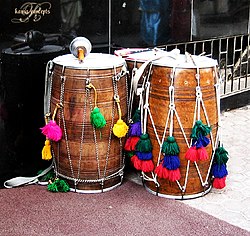

This article has multiple issues. Please help improve it or discuss these issues on the talk page. (Learn how and when to remove these template messages)
|
 | |
| Classification | |
|---|---|
| Related instruments | |
Adohol (Persian: دهل) is a large cylindrical drum with two skinheads. It is generally struck on one side with a wooden stick bowed at the end, and with a large thin stick on the other side, though it is also played with the bare hands. It is the principal accompaniment for the Sorna. A similar instrument, the Dhol, is used in traditional Egyptian, Pakistani and Indian music.
InBalochistan it mostly performed by forming a circle by a group of people, dancing and clapping. Do-Chapi almost always includes Sorna and Dohol.[1][2]
dohol and Tombak play at baloch weddings in Muscat.[3]
The dohol is largely played in Kurdistan with the zurna.
The dohol in Iran is mostly played in wedding ceremonies and other celebrations. The dohol is mostly played with a sorna.
The dohol in Afghanistan is mostly played on special ceremonies such as wedding ceremonies. The "Surnay or Sorna" is mostly played with it. The Afghan dance Attan is traditionally performed with both the Dohol and Surnay.
{{cite web}}: CS1 maint: bot: original URL status unknown (link)
|
| |||||||||
|---|---|---|---|---|---|---|---|---|---|
| Stringed (Sāzhāy-e Zehī) |
| ||||||||
| Woodwind (Sāzhāy-e Bādī) |
| ||||||||
| Brass |
| ||||||||
| Percussion (Sāzhāy-e Kūbeheyī/Zarbī) |
| ||||||||
Afghan traditional music | |||||||||
This article relating to membranophones is a stub. You can help Wikipedia by expanding it. |